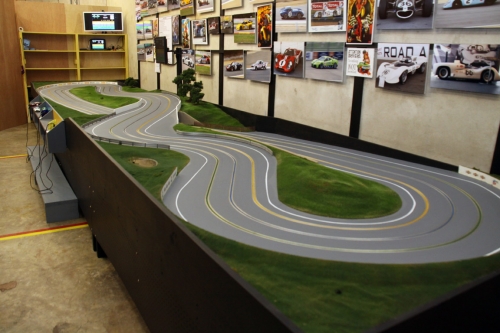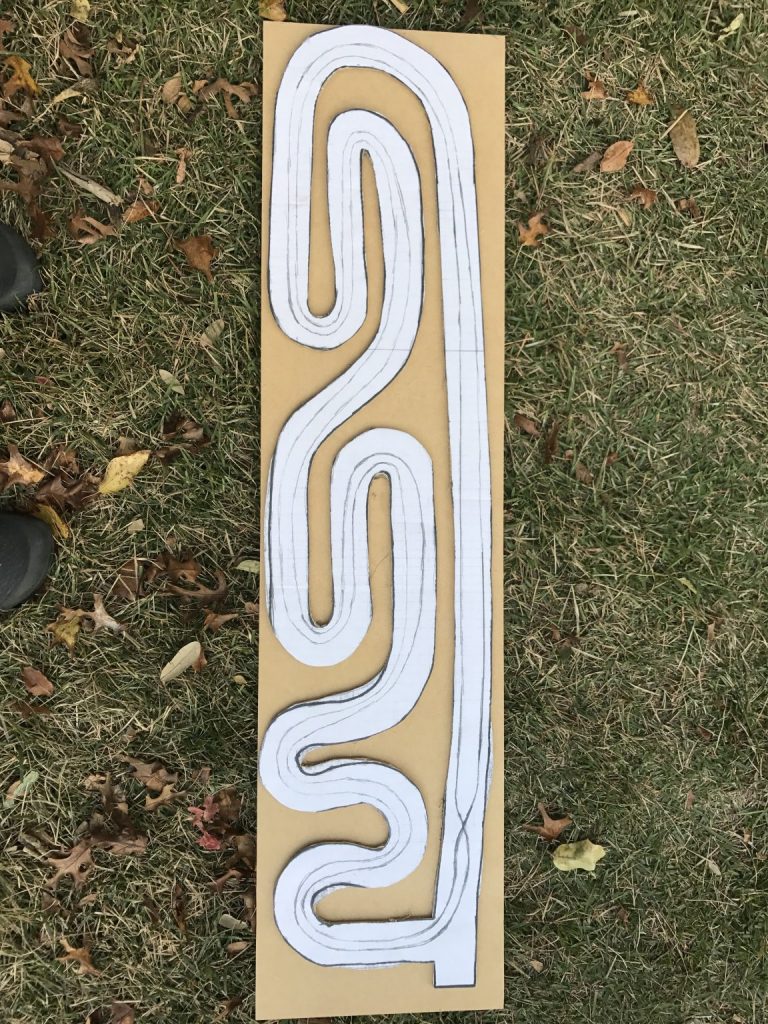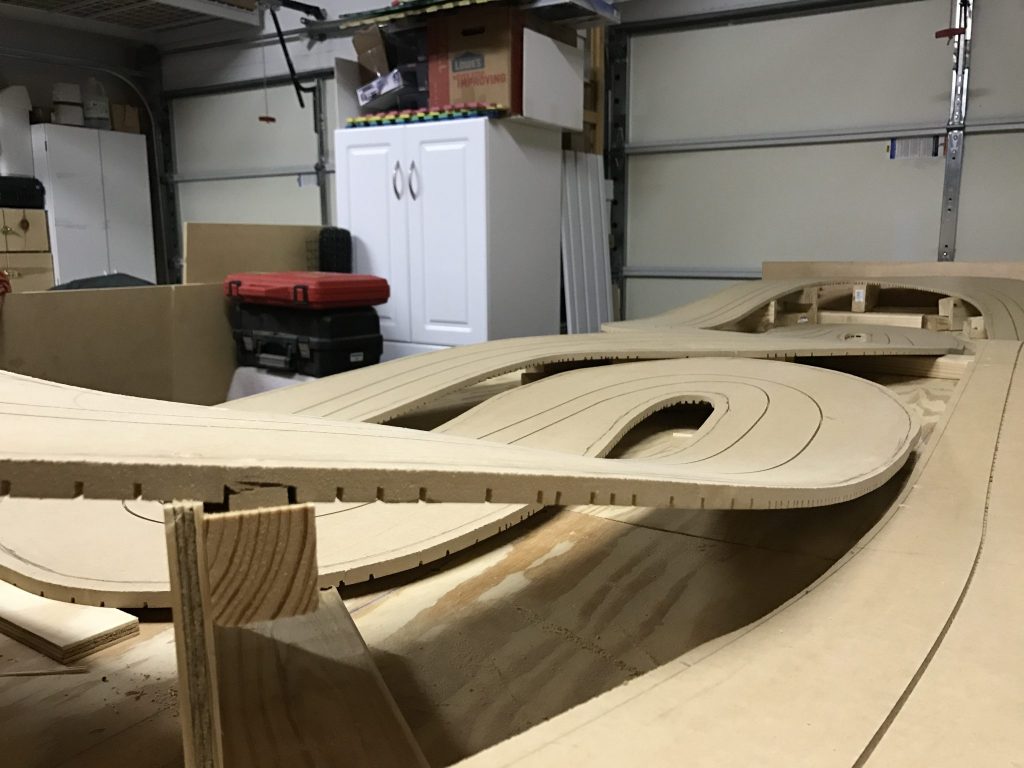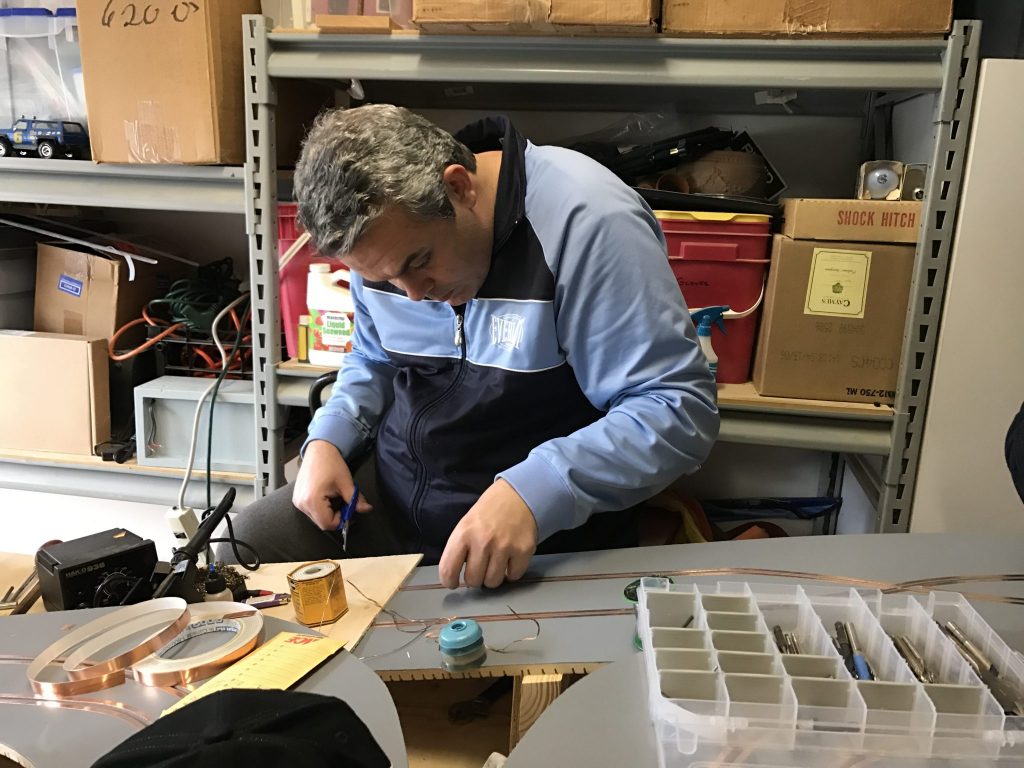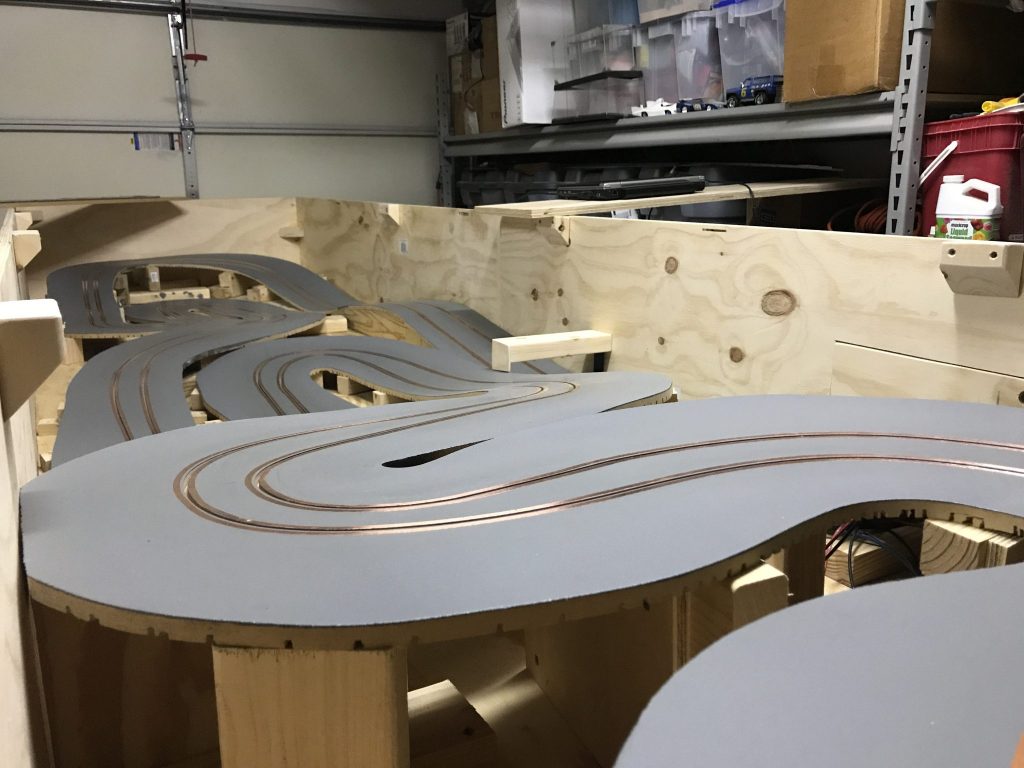Road Track
The Austin Slot Car Club’s Main Track is a custom built, three lane wood track with an average lane length of 54 feet (16.46 meters). Lane spacing is constant at 4.5 inches (11 cm) so that 1:32 and 1:24 scale cars can be raced. The track is tastefully landscaped, however great care has been taken to ensure that there are no sightline barriers to impede racers’ vision.
Lanes are powered by a Pyramid PS26KX adjustable power supply that delivers between 6 and 15 volts DC at up to 22 amps. Timing is handled by a Trackmate timing package utilizing an overhead light bridge and Trackmate and/or PC Lapcounter software. Driver stations are outfitted with female XLR connectors wired with Black (Track) on pin 1, White (Positive) on pin 2, and Red (Brakes) on pin 3 – which indicates a Positive Polarity wired track. Details about the wiring of the track and controllers can be viewed in this Forum topic.
Quick Reference Summary
| Lane Length: | 54 ft (16.46 m) |
| Driver Station Connector: | Female XLR (B:P1, W:P2, R:P3) |
| Power Supply: | Pyramid PS26KX |
| Voltage: | 6 to 15 VDC at 22 amps |
| Timing System: | Trackmate w/ LED Light Bridge |
Rally Track
The club’s first track was built by its founders in a span of about six months with everyone working every weekend. It was a lot of work but the result and the friendships that came from it were well worth the time and effort.
The idea for a new track had been kicking around for a while now it was just a matter of building it. That is easier said than done. However, all that changed at our annual club meeting in October of 2015 when the club decided to run a rally series that would require a new track. A rally track. Something very different than our current track. The rally series was approved and the new track would be designed and built for Q4 of 2016.
The design for the track started in April and went through numerous revisions before the final design was selected. The track was designed around the following criteria:
- fit in a space of 14’x3.5’
- one lane with two loops
- able to be driven in both directions
- lots of elevation change
- plenty of room for sliding a car around the turns without coming in contact with the landscaping
- unobstructed view of the entire track from the drivers station
The track would be different than many routed rally tracks in that it has plenty of room for the longest rally cars to slide wide without de-sloting. How important is the room to slide wide? It depends who you talk to. I have always believed that a track should be designed and built so that it would not be the cause of a de-slot. Having said that, I have seen many rally tracks that have obstacles included in the basic design of the track itself and would force the driver to control their pace. The challenge of this track will be its design – significantly tighter turns and shorter straights. This is a big departure from the clubs current track. It’s not so much a rally track as a tight and twisty road course. Sort of the Targa Florio meets the Rally Germany. Not to say you can’t get into trouble by carrying too much speed into a turn. Run off the track and you will find yourself in a ditch or other off track barrier that will surely dirty up your tires and make the next lap very difficult.
The summer went by and little work happened on the track as other priorities and races took precedent. As the rally series drew closer and conversations about the new track started to come up I told the group how we built our current track, the special tools we used to rout it and the time involved and how I “should” be able to get it done in time. Our newest club member, Alejandro, informed me that he had access to a digital router and could do the routing as long as we had the track design available in a digital format. This would save weeks of time, effort and expense. What a stroke of luck. Now all I needed was someone to render the track design. Thank goodness we have someone in the club that can make that happen – Stephen. He was able to take my rough drawings and digitized them. A tough job in its self. Once Stephen had the track fully rendered he emailed it to Alejandro for review and routing.
Ary took the two sheets of ½” 4’x8’ MDF to Alejandro and the routing began. Alejandro worked his router magic and after a couple of hours we had our new rally track. For anyone that has ever routed a track it’s crazy to see how easy it is for a digital router to take what was a week’s long project and turn it into an hour of precision work with no filler needed to fix your router mistakes.
Ary dropped it off the routed sheets at my house where we put it up on the 14’x3 ½’ table that was already built and ready to use. The table was up on three saw horses so the track would be higher and easier to work on. With the track on the table I was able to use my favorite Fly Lancia 037 to check the runoff area and mark the cut out line for the track. Once again, the idea was to leave enough room for even the longest rally car slide around the turns without hitting anything. As drawn, the track had plenty of runoff room in both directions and was easy but time consuming to outline.
I was pushing to get some work done on the track with the hopes of having it done sooner than later but the weather was cold and wet so I decided to cut it out in the garage – super messy with MDF. I had never worn a mask or something to cover my eyes but after this I realized my mistake. My eyes were scratchy for two days and I couldn’t drink enough water to get the MDF out of my throat. No matter what my ailments were the track was now cut out.
The next step was to cut slots on the bottom of the track that run perpendicular to the routed lane. These cutouts needed to be done every 3/8” with the purpose of allowing the MDF to bend as much as we needed it to do to achieve the elevation change I was looking for. This was the messiest work yet. With Alejandro, Russell, Randy and Myself we took the track outside, installed the correct cutting blades on our circular saws and started cutting. Once the dust settled we were able to check out the track and being mounting it to the table
We started mounting the track and did about half of it before the energy and daylight faded. It was looking great and everyone was excited at what it was beginning to look like. It was hard to escape the fact that this track was very different from the clubs current track. I could not help thinking that this would either be one of the most fun track to drive or one of the worst. I don’t know if there would be an in between. It sure looked like it would be fun and very challenging.
As we moved the track back in the garage Russell and Alejandro were asking what the plan was for storing the track at Kings. All of the ideas we had talked about in the past about raising it up to the rafters were thrown out the window as we were all concerned about the weight of the track at this point. No one had any answers but I could not imagine we could not come up with something. We were all too tired at this point.
For the next two weeks, as time permitted, I would add track supports and get the track elevations and camber as perfect as I could. Once all the track supports were installed and the track completely screwed down there was only one turn that had a negative camber. Not too bad for a track with so many turns and elevation.
Next job was to fill all the screw holes and gaps in the track with wood filler. This was done on a Friday night and the club was invited to the house on Saturday to help with the next steps of sanding the filler, do an extensive cleaning of the track and paint the track surface.
At the clubs last race of the year we again talked about where we might put the track at Kings. We measured areas all over the back of the store, we measured areas in the store, we talked about hinges and pulleys we talked about storing it on its side but no real good ideas were coming up. Then someone came up with the idea of leaving it on the floor next to our current track. The footprint would be just enough that it would fit and still allow access to the current work benches. We would install casters on it so we could move it around as needed. We had the idea to put a top on it and use it for more pit box space when we were not racing on it. We would maximize the space it would take up by building storage spaces beneath the track for members to store their pit boxes or other items. We would design it so we could lock down the top so the track would not be for general use but just for the club.
Russell set about the job of building the table and only a week after the first discussions the table was built and ready and waiting to support the new track. In the meantime, while the track was still under construction, it worked great at the serving table for the clubs Christmas party buffet.
Lane Length: 2 Loops = 1 Lap
Loop 1 = 44’ 4 3/32”
Loop 2 = 44’ 4 7/32”
Total for 1 lap = 88’ 8 5/16”
Driver Station Connector: Female XLR (B:P1, W:P2, R:P3)
Power Supply: Pyramid PS26KX
Voltage: 6 to 15 VDC at 22 amps
Timing System: Trackmate w/LED Light Bridge
Track Braid: Copper Tape
Track Surface: ½” MDF
Elevation Change: 14”

